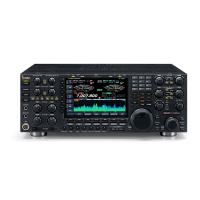
Do you have a question about the Icom IC-7800 and is the answer not in the manual?
| Brand | Icom |
|---|---|
| Model | IC-7800 |
| Category | Transceiver |
| Language | English |
Key capabilities of the IC-7800 transceiver.
Description of controls and indicators on the front of the transceiver.
Details of connectors and ports on the back of the transceiver.
Specifications for the ACC connectors.
Explanation of indicators and readouts on the LCD screen.
Initial steps for setting up the transceiver.
Proper grounding procedures for safety and performance.
Essential connections for basic operation.
Connecting external equipment for expanded functionality.
Connecting external linear amplifiers.
Connecting devices for data mode operations.
Details on compatible microphones and their connections.
Procedure for initial power-on and CPU reset.
Selecting between the main and sub receivers.
Methods for tuning and setting frequencies.
Switching between different communication modes.
Adjusting audio output levels.
Steps and considerations for transmitting.
Detailed functions for Single Sideband operation.
Detailed functions for Continuous Wave operation.
Features for CW keying and memory operation.
Detailed functions for RTTY operation.
Detailed functions for PSK operation.
Detailed functions for Amplitude Modulation operation.
Detailed functions for Frequency Modulation operation.
Visualizing signal characteristics on a spectrum display.
Enhancing receiver sensitivity for weak signals.
Fine-tuning the receive frequency for clarity.
Controlling automatic gain for stable audio output.
Adjusting IF filter passband for interference rejection.
Simultaneously monitoring two frequencies.
Reducing impulse noise from sources like ignitions.
Eliminating unwanted beat tones and interference.
Enabling hands-free transmission via voice activation.
Automatic transmit/receive switching in CW mode.
Shifting transmit frequency independently of receive.
Transmitting and receiving on different frequencies.
Recording received and transmitted audio for a QSO.
Listening to recorded QSO audio files.
Recording custom messages for transmission.
Transmitting pre-recorded voice messages.
Storing and managing frequencies and operating modes.
Methods for selecting stored memory channels.
Saving new frequency and mode data into memory.
Temporarily storing frequencies and modes for quick recall.
Overview of available scanning modes.
Steps required before initiating a scan.
Controlling scan pauses based on voice detection.
Scanning between programmed frequencies.
Scanning through stored memory channels.
Detecting subaudible tones for repeater access.
Connecting and selecting antennas for operation.
Storing antenna configurations for different bands.
Using the built-in antenna tuner for impedance matching.
Setting the current date and time.
Configuring automatic power ON/OFF schedules.
Setting the timer for automatic transceiver power off.
Overview of the transceiver's programmable settings.
Adjusting audio tone levels for transmit and receive.
Configuring accessory connector functions.
Customizing screen appearance and indicators.
Miscellaneous system configuration options.
Managing settings on memory cards and USB drives.
Backing up transceiver settings to external media.
Restoring transceiver settings from external media.
Diagnosing and resolving common operational problems.
Checking antenna performance via SWR meter.
Procedure for replacing internal fuses.
Understanding transceiver protection system alerts.
Details on connecting and controlling via CI-V interface.
Comprehensive command table for CI-V operations.
Descriptions of data contents for CI-V commands.
Detailed technical specifications for the transceiver.
Receiver and antenna tuner specifications.
List of compatible optional accessories.
Overview of firmware update process and benefits.
Critical warnings and recommendations for firmware updates.
Steps and requirements before performing firmware update.
Procedure for updating firmware using a memory device.
Procedure for updating firmware via PC connection.
Guidelines for physical installation and antenna placement.
Compliance certifications for Radio and Telecommunications Terminal Equipment.